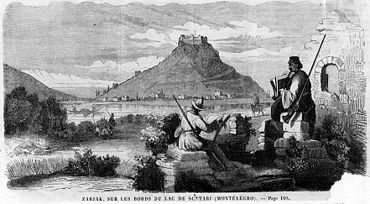
Žabljak Crnojevica
Encyclopedia

Cetinje
Cetinje , Цетиње / Cetinje , Italian: Cettigne, Greek: Κετίγνη, Ketígni) is a town and Old Royal Capital of Montenegro. It is also a historical and the secondary capital of Montenegro , with the official residence of the President of Montenegro...
in Montenegro
Montenegro
Montenegro Montenegrin: Crna Gora Црна Гора , meaning "Black Mountain") is a country located in Southeastern Europe. It has a coast on the Adriatic Sea to the south-west and is bordered by Croatia to the west, Bosnia and Herzegovina to the northwest, Serbia to the northeast and Albania to the...
.
Location
The fortress itself is located on the confluence of the Morača river in Lake Skadar. It is believed that this fortress was founded in the tenth century during the reign of the Vojislavljević dynastyHouse of Vojislavljevic
The Vojislavljević was the second Serb medieval dynasty, named after archon Stefan Vojislav, who wrestled the region from Byzantine hands in the 1040s...
in then-known Dioclea
Duklja
Doclea or Duklja was a medieval state with hereditary lands roughly encompassing the territories of present-day southeastern Montenegro, from Kotor on the west to the river Bojana on the east and to the sources of Zeta and Morača rivers on the north....
, whereas the first known written testimony of the fortress originate from mid-fifteenth century. The fortress served as the capital of Zeta
Principality of Zeta
Zeta was a medieval state, which territory encompassed parts of present-day Montenegro and Northernwestern Albania. From 1360. to 1421. Zeta was independent state administered by local noble family Balšić. From 1185. to 1360. and from 1421. - 1451, Zeta was province of medieval Serbia...
under the Crnojević dynasty
House of Crnojevic
The Crnojević was a medieval Serb noble house that held Zeta, or parts of it; a region corresponding to north of Lake Skadar , from 1326 to 1362, then 1403 until 1515. The progenitor, Đuraš Ilijić, was head of Upper Zeta in the Serbian Kingdom and Empire The Crnojević was a medieval Serb noble...
from 1466 till 1478, being the seat of Stefan
Stefan I Crnojevic
Stefan a.k.a. Stefanica Crnojević was a medieval lord of the Principality of Zeta , from the House of Crnojević that ruled it from 1451 to 1465.-Reign:...
and Ivan Crnojević. However, Ivan Crnojević was forced to move the capital in 1478 as the Turks
Ottoman Empire
The Ottoman EmpireIt was usually referred to as the "Ottoman Empire", the "Turkish Empire", the "Ottoman Caliphate" or more commonly "Turkey" by its contemporaries...
seized the town that same year, holding it until the decision of the Berlin Congress
Congress of Berlin
The Congress of Berlin was a meeting of the European Great Powers' and the Ottoman Empire's leading statesmen in Berlin in 1878. In the wake of the Russo-Turkish War of 1877–78, the meeting's aim was to reorganize the countries of the Balkans...
in 1878 when it fell under Montenegrin administration
Principality of Montenegro
The Principality of Montenegro was a former realm in Southeastern Europe. It existed from 13 March 1852 to 28 August 1910. It was then proclaimed a kingdom by Knjaz Nikola, who then became king....
once again after 400 years of Turkish rule. The town has tall walls with towers, as well as one gate. Within the walls can be found: Ivan Crnojević's court, Church of Saint George
Saint George
Saint George was, according to tradition, a Roman soldier from Syria Palaestina and a priest in the Guard of Diocletian, who is venerated as a Christian martyr. In hagiography Saint George is one of the most venerated saints in the Catholic , Anglican, Eastern Orthodox, and the Oriental Orthodox...
(was turned into a mosque during Ottoman rule), housing and military facilities, a warehouse for clothes and a water tank, most of which are preserved.
Demographics
In the early 17th century, the town was under Turkish rule. The fortress had only one resident, the Dizdar Aga (Turkish official).Of the 250 houses, the majority were Serb.

